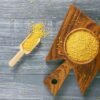Source: https://www.wellcurve.in/blog/different-types-of-flour-name-list/
Introduction
For a cook, flour is the most important ingredient, especially in an Indian kitchen. We use flour in almost all of our recipes. It serves as the basis on which we construct other flavors. It contains the most of our favorite baked goods, including buttery biscuits, flaky pie crust, a soft fluffy chapati and basic sandwich bread.
While any cereal or millet can be ground into a fine flour and can be used to make a variety of products, including bajra flour, ragi flour, or even the commonly used rice flour. However, the most common type of flour not only in an Indian kitchen but in any kitchen around the world is plain old wheat flour.
While this question may never have bothered many people, there are still some perfectionists who have wondered- What exactly is the right kind of flour to use?
It can be challenging to choose the right type of wheat flour because there are so many available. Do you require whole wheat flour, all-purpose flour, high gluten flour, or any of the other types of flour?
You must be aware of what to search for to aid in your decision. You can make sense of the wide variety available by knowing your flour’s protein content, hardness, and extraction rate.
The main differences between the various types of flour are only these two things:
1. Processing Methodology
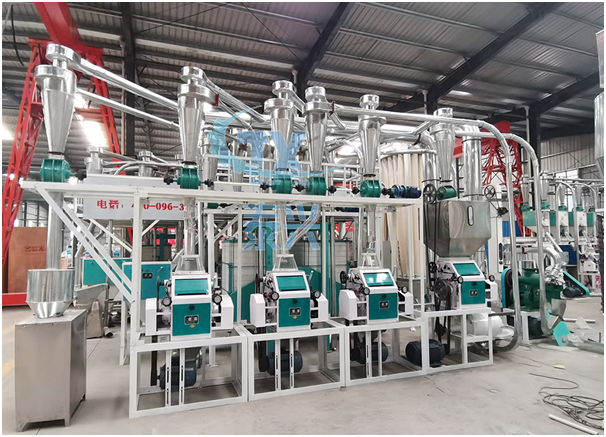
Source: https://www.taixingmachinery.com/products/wheat/30.html
Flour behavior is affected by processing. Before wheat is converted into flour, it must first be ground through a number of roller mills, sieves, etc. Manufacturers can adjust a number of variables that affect the characteristics of the flour, including:
- Bleaching: The majority of flour producers bleach their flour to give it an unnaturally white appearance using substances like chlorine dioxide and benzoyl peroxide. By delaying oxidation and the development of off flavors, it helps to extend the shelf life of the flour. The behavior of flour is affected by bleaching as well.
- Particle Size: Particle size is an additional variable. Semolina is one type of flour that is purposefully milled to have larger particles than other types of flour. Cake-making flour is typically ground more finely than bread-making flour.
- Extraction Rate: The extraction rate is used by manufacturers to specify exactly how much is sieved out. An extraction rate of 95–100% applies to whole wheat flour. In other words, the amount of bran, germ, and endosperm is the same as it would have been in the original wheat. On the other hand, white flour typically has an extraction rate less than 75%. Neither the germ nor the bran are present.
- Ash Content: The term “ash content” describes how much ash would remain after burning 100 g of flour. More germ, bran, and outer endosperm are present in the flour, which is indicated by a higher ash content. A lower ash content indicates a higher degree of refinement in the flour i.e. a lower extraction rate.
2. Wheat variety
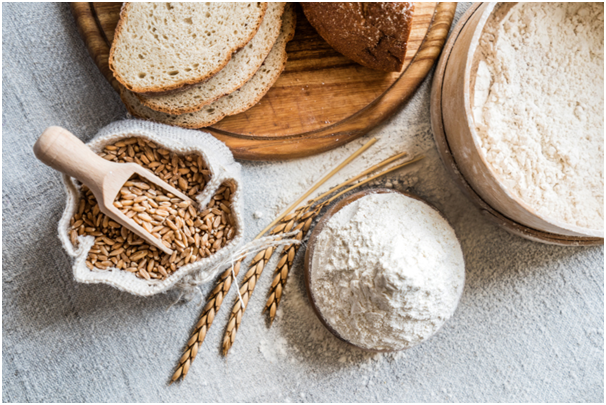
Source: https://www.goodness.com.au/blog/guide-to-flour-types-and-uses/
Application of the flour is dictated by the wheat variety. The process of milling wheat kernels into flour produces all types of wheat flour. However, not all wheat kernels are equal. Around 20 wheat varieties from seven species are grown around the world.
- Hardness: Wheat grains are subjected to a great deal of pressure during milling to ensure that they shatter into smaller pieces. Some varieties of wheat are extremely tough and difficult to break. Some are easier to break and, consequently, mill because they are softer.
-
The starch granules within a wheat kernel are likely to be damaged if it is more difficult to break the wheat kernel. Undamaged starch is less able to absorb water than damaged starch. This may be desirable for breads but not so much for cakes. Because of this, softer flours are frequently used for cakes while harder flours are better suited for breads.
- Gluten Content: Making any kind of flour-based product requires the use of gluten because it affects the product’s texture, density, and final composition.
Gluten is a protein that occurs naturally in grains such as wheat, barley, and rye. It functions as a binder, securing the food and giving it a “stretchy” quality.
For cakes and other baked goods that don’t need gluten, cake, all-purpose, or pastry flours are used. This is so that they aren’t required to be elastic and can be denser so that they maintain their shape without stretching.
Gluten is necessary for breads to have that slightly stretchy, fluffy, or layered texture, whether they are leavened or not. A large amount of gluten is required to make chapati. The product will be better the more gluten it contains.
- Protein Content: You need wheat flour with a high protein content if you want to make good, fluffy bread or pasta. The dough can be pulled and stretched thanks to the proteins in gluten. On the other hand, if you’re making a delicate tart shell or baking a cake, you don’t want any gluten to form, so you need a low-protein flour.
A flour’s protein content is entirely dependent on the type of wheat used to make it and how it was raised. The protein content doesn’t change after harvest. Flours based on their difference in protein amount are discussed below:
 Source: https://www.goodness.com.au/blog/guide-to-flour-types-and-uses/
Source: https://www.goodness.com.au/blog/guide-to-flour-types-and-uses/
- Whole wheat Atta: 13-15% protein– It is the Indian type of whole wheat flour that is processed in a chakki. It is the best type of flour to make chapati or the indian flatbread which needs a granulated texture and loads whole grain goodness.
Refined or AllPurpose Flour: 11.7% protein- It is a very versatile flour. All-purpose flour has a medium protein content, so you can use it in any recipe that calls for flour, but it works best in baked goods like cookies, muffins, quick breads, and pie crusts.
- Bread Flour: 12.7% protein- The potential rise of yeast bread increases with protein content.
- White Whole Wheat Flour: 13% protein- This flour functions more like all-purpose flour and has a similar nutritional profile to whole wheat, but it has a milder flavor and lighter color.
- Whole Wheat Flour: 14% protein- To produce a stronger, more distinctive flavor and more nutrition, whole wheat flour is milled from the entire wheat grain, including the bran and inner germ.
- Self-Rising Flour: 8.5% protein- The creamy and light texture of this flour is admired by bakers around the world. Salt and baking powder is added for a better combination.
-
Summary
Despite the significant role flour plays in our kitchens, it is frequently forgotten when discussing ingredients. We carefully select the other ingredients in our recipes, weighing the pros and cons of various chocolates and cheeses but the base of the dish, the flour is often overlooked.
Chapati Flour
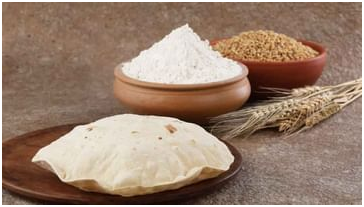
Source: https://images.tv9telugu.com/wp-content/uploads/2021/12/chapati-flour.jpg?w=360
The most widely used types of flour, including cake flour, pastry flour, self-rising flour, gluten-free flour, and refined flour, are absolutely unacceptable for making chapati. To make the perfect chapati, high gluten flour is required.
Cake flour
 Source:https://images.immediate.co.uk/production/volatile/sites/30/2020/08/plain-flour-cakes-hero-01614ff.jpg
Source:https://images.immediate.co.uk/production/volatile/sites/30/2020/08/plain-flour-cakes-hero-01614ff.jpg
In comparison to all-purpose flour, cake flour has a lower extraction rate and lesser protein.
Bread flour
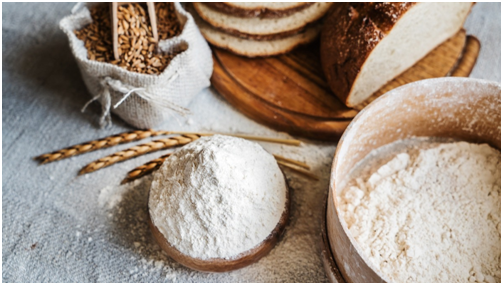 Source: https://images.ctfassets.net/3s5io6mnxfqz/4KSsd7fAaUYc1KQR4gQrgm/6341908419781460849f61c24b55da10/AdobeStock_349431339.jpeg
Source: https://images.ctfassets.net/3s5io6mnxfqz/4KSsd7fAaUYc1KQR4gQrgm/6341908419781460849f61c24b55da10/AdobeStock_349431339.jpeg
There is a lot of protein in bread flour. It is typically milled similarly to all-purpose flour in terms of extraction rate, but it is made from various types of wheat as opposed to all-purpose flour.
Self-rising and all-purpose flour
 Source:https://www.jessicagavin.com/wp-content/uploads/2017/12/types-of-flour-1-1200.jpg
Source:https://www.jessicagavin.com/wp-content/uploads/2017/12/types-of-flour-1-1200.jpg
All-purpose flour is designed to be suitable for all intended uses. As a result, it is passably good at a variety of things rather than excellent at any one. It has a suitable extraction rate and a moderate protein content for white flour.
References
- How do you choose the right flour? | King Arthur Baking
- The Best Flour For Chapati In 2022 – Foods Guy
- How to Choose the Right Type of Flour – FoodCrumbles











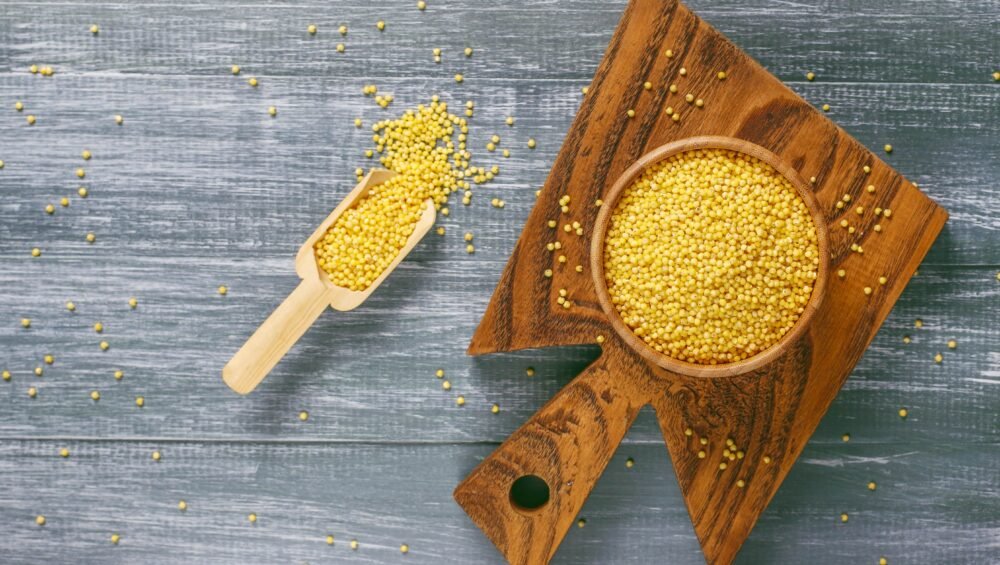



 Source:
Source: 
 Source:
Source: Source:
Source:  Source:
Source: